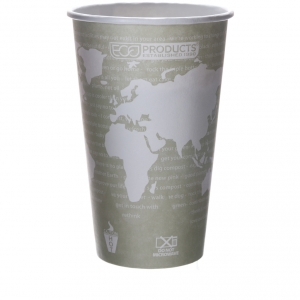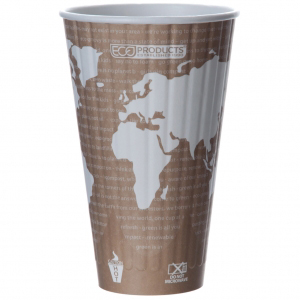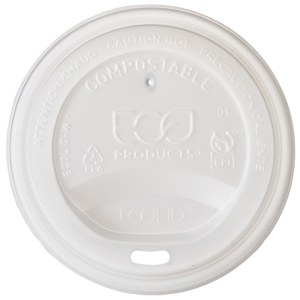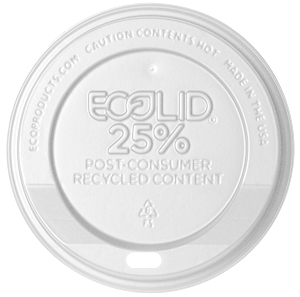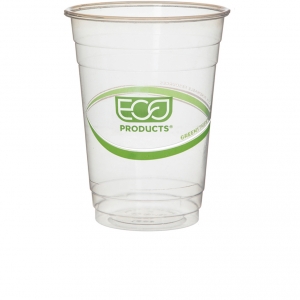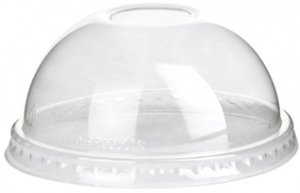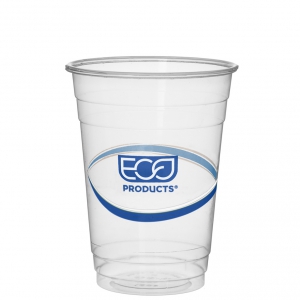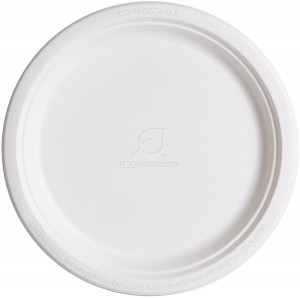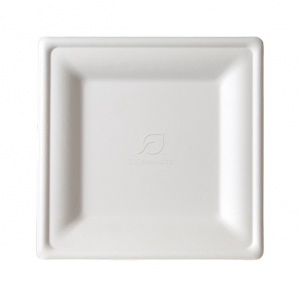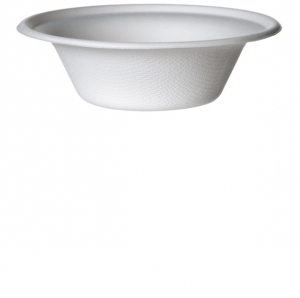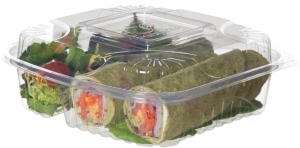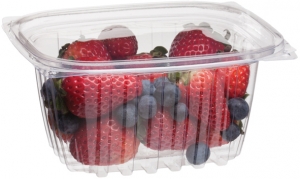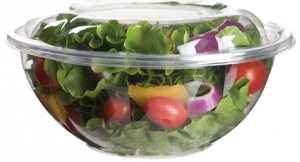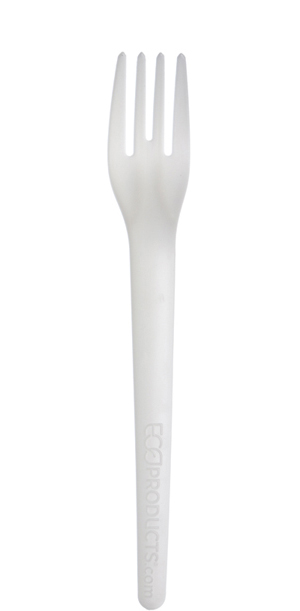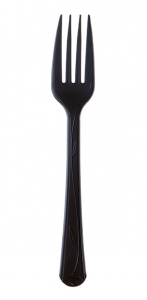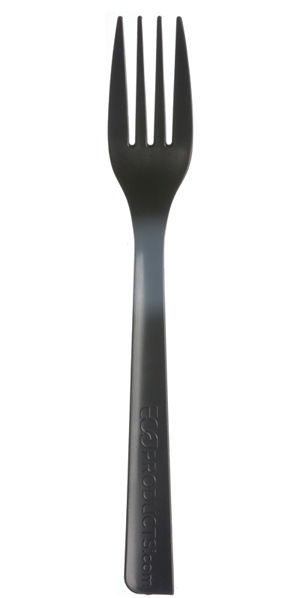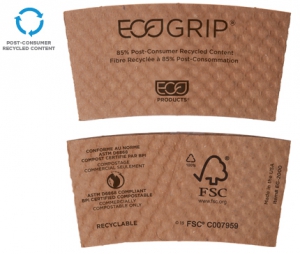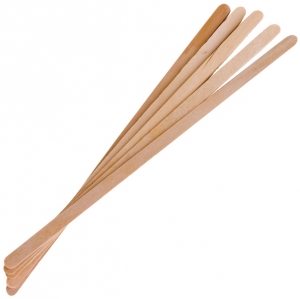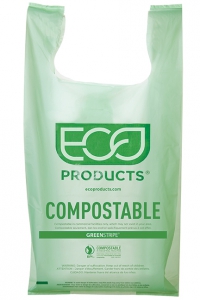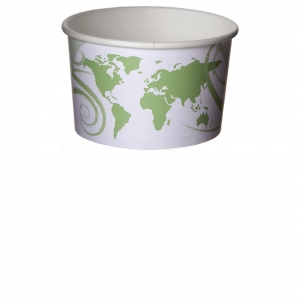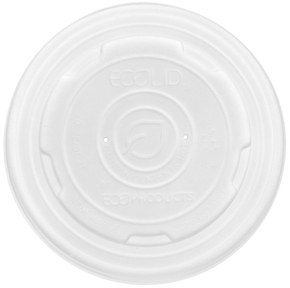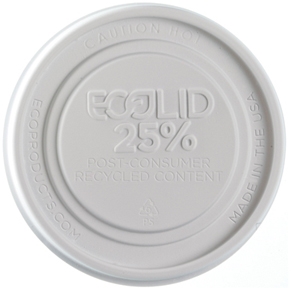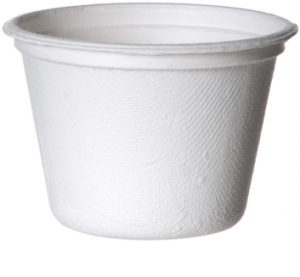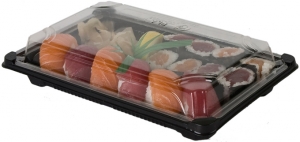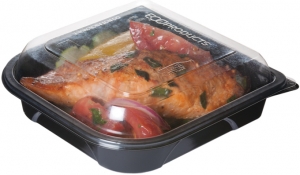FAQ
We know you may be new to our products and materials, or just have a question about our company.
Follow these links to find the answers to the questions we get asked the most.
If you can't find the answer to your question here, feel free to contact our expert at sustainabilitymaven@ecoproducts.com
You can buy them online at our store www.ecoproductsstore.com or you can get them from a distributor. Use this tool to find a distributor in your area.
You can find product specific information on our product information pages but in general:
| Product material | Freezer | Microwave | Oven |
| Paper | Yes (short term storage only) | No | No |
| PLA | No | No | No |
| Sugarcane | Yes (short term storage only) | Yes | No |
| RPET | Yes (short term storage only) | No | No |
Paper and Sugarcane products can go in the freezer, although they are not airtight, so freshness and freezer burn can become issues if left there too long. PLA and RPET can become brittle when frozen, so we don't recommend putting these products in the freezer.
While our hot cups, soup cups and some containers are designed for hot foods, they are not designed for the extreme heat of the microwave. Microwaves will cause them to warp, leak or even catch on fire. Unless a disposable product says "microwave safe" on it, it's a good idea to use a glass container to reheat your food instead.
Lined molded fiber products will hold liquids well and are grease- and cut- resistant. Unlined fiber products work well too, but like paper, they may be more likely to lose strength when used with very hot foods or liquids.
No, our products are not edible. They are FDA approved for food contact, but are not considered edible/digestible. Even though many of our products are derived from plants, they are plastic and should not be eaten.
Paper hot cups and soup cups are designed to hold hot drinks and food, but not to withstand the extreme heat of a microwave. At best, the glue at the seam can loosen and the cup will start to leak. At worst, the cups can even catch on fire! This is true for all paper cups, not just ours. We recommend microwaving in glass or ceramic containers labeled as microwave safe.
Yes. Eco-Products warrants the products supplied to be free from manufacturing defects. The Eco-Products warranty does not cover defects attributable to or resulting from normal use, inappropriate storage, shipping or handling. Eco-Products retains the right to request product samples, whether damaged or otherwise, to be returned to Eco-Products at a determined destination for inspection prior to replacement or credit for said goods.
If a replacement is made, Eco-Products shall have a reasonable time to deliver such replacement goods. If, after inspection, Eco-Products determines that the products are defective, we will offer replacement product or credit.
This is a great question with a complex answer! How long it takes something to break down depends on what kind of material it is (e.g., a piece of paper breaks down much more quickly than a corn cob), what kind of composting technology is used (e.g., a backyard pile overseen by a gardener is very different than a commercial facility with millions of dollars in equipment to manage moisture and temperature), and what climate you’re in (e.g., the dry Arizona desert is very different than the humid Pacific Northwest). Most of the compostable products Novolex makes are designed to be composted in commercial facilities, where temperature, moisture, oxygen, and other factors can be carefully monitored. The Biodegradable Products Institute certifies many of our products, and the testing upon which that certification is based allows up to 180 days for biodegradation to occur. However, given the number of variables involved, in reality there is a wide range of time in which compostable products to break down. Some composters have successfully composted packaging in as little as 45 – 60 days. For more information on the composting process, check out this video by Eco-Products: https://www.youtube.com/watch?v=s_27lJ3NQO4&t=3s
We recommend disposing of PLA products in a commercial compost facility where they can be broken down, turned into compost and then returned to the soil. Home composting typically does not create the consistent composting conditions needed for our products, but commercial facilities can manage just fine.
Commercial compost facilities are expanding around the country and there may be one in your area. To find a compost facility near you, please visit the US EPA website or check out Find A ComposterNo, our products are not certified as marine degradable and we strongly encourage everyone to keep all plastics out of oceans and waterways.
For disposal, naturally we recommend composting if it's available, but if not, please dispose of all foodservice items responsibly. Even if these items head to the landfill, this is preferred to leaving items to escape as litter into the environment. There is still an important environmental benefit to choosing Eco-Products items over traditional foam or plastic items that contain no recycled content or renewable materials.
The terms “biodegradable” and “compostable” are not equivalent or interchangeable. “Biodegradable” simply means something will be broken down by microbes over time, which is true for most materials on the planet. An aluminum can is “biodegradable”… if you wait 200 years. Since this term applies to almost everything, it is a pretty meaningless claim and one that has been significantly abused through greenwashing. In contrast, “compostable” means something will break down in a reasonable amount of time, leave behind no toxic residue, and safely become an additive to soil.
Our products are certified compostable by a third-party organization called BPI, and they meet the strict third-party standards for each material type. That's why our products are labeled "compostable" and not "biodegradable". In the US, the Federal Trade Commission (FTC) publishes the "Green Guides" that outlines the rules for environmental marketing claims. All of our claims of compostability are in compliance with the FTC’s Green Guides. For more information: https://www.ftc.gov/news-events/media-resources/truth-advertising/green-guides
PLA items do not breakdown well in most digesters. Technology is always changing, so we hope that more digesters can work with PLA in the near future. For now, we recommend that PLA go into a land-based commercial compost facility only.
Not necessarily, PLA foodservices items will break down at about the same rate regardless of size (extremely large or dense items may take even more time). The composting process primarily depends on heat, moisture, and time, and even small pieces of PLA require the same conditions to start composting. Paper items may break down faster in smaller pieces, but commercial composters know their systems well and often will chop material into the ideal size for their needs.
No, they don't. Our sugarcane and PLA products need the right conditions to compost. They need heat, moisture and microorganisms to fully break down. Soil, water and retail shelves do not provide an optimum environment for composting.
In short, probably not. Here's why: We have 2 lines of products; our GreenStripe® items that are made with renewable resources and our BlueStripe™ items that are made with recycled content materials. Not all of these materials can be recycled most places in the US.
Most of our GreenStripe® items are compostable. So when you are done with these renewable GreenStripe® items, like PLA (a plant-based plastic) products, they can be disposed of in a commercial compost facility instead of the landfill. Here they are retuned to the soil as compost.
Our BlueStripe™ items are made from post-consumer recycled PET plastic, polystyrene or fiber, so we are excited to give a second (or third) life to these materials. Unfortunately, it can be hard for some recycling facilities to capture these items – instead, their environmental benefit lies in their front end materials. For these items, please dispose of them responsibly and only recycle them if they are accepted.
Coming soon! There are some regions where #1 PET recycling has expanded and you can put our BlueStripe™ PET items in the recycling bin. It's not everywhere yet, but hopefully one day soon. We encourage you to check with your local municipality or materials recovered facility (MRF for short) to see if they are accepted and if not, to learn when they will be.
Note: It can be tricky to tell the difference between a clear PLA cup and a nearly identical cup made from petroleum-derived plastic like PET or even recycled PET. Check out the resin identification number on the bottom of the cup – PLA cups are labeled with #7 and PET cups are #1.
Recycling facilities can have problems with PLA items, so it is important to separate compostables from recyclables into "clean" waste streams. Because PLA and PET mix about as well as oil and water, recyclers consider PLA a contaminant and compost facilities have a hard time cleaning it out of the compost.Today, very few communities recycle paper hot cups of any type. This is because separating the cups’ film lining from the paper can be difficult and because food contamination can decrease the value of the material.
Hot cups in our GreenStripe® line (i.e., GreenStripe, WorldArt, Slate, This Is Why) are made with renewable resources. These cups are made with paper from trees harvested in North America; they are lined with PLA, a plant-based plastic. They are certified to be commercially composted after use. If you are not lucky enough to have a commercial composter in your area, these cups should be sent to the landfill.
Hot cups in our BlueStripe™ line (i.e., BlueStripe, Evolution World) are made with post-consumer paper fiber and a polyethylene lining. To our knowledge, our 24% post-consumer fiber is the highest percentage of post-consumer material in this type of cup! These cups are not compostable, and because of the challenges mentioned above with recycling paper hot cups, they are not recyclable in most communities either. Eco-Products is participating in industry initiatives aiming to increase the recyclability of hot cups and other foodservice packaging. We hope that one day soon, diverting these products from the landfill will be the norm and not the exception.
The answer is: it depends!
Here at EcoProducts, we look at our products from a life cycle perspective. Our cups have a beginning, middle and end of life. For our cold cups, some of them have great beginning of life attributes, while the others offer great end of life benefits. However, a key piece of the environmental success of our products depends on you. Simply choosing Eco-Products over conventional products helps drive markets, keep good companies like us in business and show the industry where consumers are motivated. If that is all you can do right now, that is a great start! Some of you can do more by composting or even recycling (where accepted) some of our products. The best environmental solution is the one that works with you.
See our GreenStripe® and BlueStripe™ page to learn more about each product's attributes and what fits into your life right now.
Compostable items are designed to be composted in a compost heap only. Composting is a very specific process which does not occur in landfills. Microorganisms, carbon, water, oxygen and nitrogen are all essential parts of the compost process and these factors need to be present in the right circumstances (such as in a compost pile) for composting to occur.
If compostable products are placed in an open landfill or dump where oxygen is available, they will decompose at a rate similar to other biodegradable materials in the same setting. If compostable products are placed in the more common anaerobic (air-locked or capped) landfill and deprived of oxygen and micro-organisms, then the ability of the compostable products to decompose will be severely restricted. This is true of all biodegradable materials placed in this setting, including paper, yard waste and food waste.
As a consumer, you should be skeptical of any manufacturer making claims that their products will biodegrade quickly in an air-locked landfill. Eco-Products clearly labels and certifies all our compostable products to help consumers and composters alike.
In a capped landfill (the most common type of landfill in the US), our products and most plastics will remain stable and not be a significant contributor to methane emissions as far as we know. Compostable PLA plastic breaks down in aerobic composting scenarios best, and composting is not a significant source of methane. Composting is a specific aerobic (oxygen rich) process which occurs in compost piles only, not inside sealed anaerobic (oxygen deprived) landfills. Other bioplastics have shown different results in landfills, and some bioplastics are being engineered to behave differently in landfills. Eco-Products uses PLA plastic exclusively in our compostable products, and it is tested and clearly marked for commercial compost.
Methane in landfills results from organic materials that end up in anaerobic (air-locked or capped) landfills and are deprived of oxygen and micro-organisms. Over long periods of time, organic material slowly degrades anaerobically resulting in the creation of methane gas. Methane gas is more harmful to the atmosphere than CO2 over its lifetime. Landfills are the second largest source of man-made methane emissions in the US, and much of this is attributed to the long legacy of organic matter anaerobically decomposing in the landfill and making methane gas. This is why it is more important than ever to keep as much organic matter like food scraps, yard waste, and agricultural waste out of the landfill. Plastics are generally stable in the landfill, and things like foam will stick around for a very long time – we are not sure when they will ever really break down.
The number inside the chasing arrow symbol is called a resin code - it indicates the type of plastic the product is made with. On our products, the #7 code indicates PLA.
In the wider world of plastic containers, the #7 is a catchall category that includes a variety of plastics and plastic composites. So keep in mind that not all containers labeled with #7 are made with PLA. Look for additional labeling like "Compostable" or "BPI" to determine if a container is compostable.
Learn More
US EPA Resource Conservation Page for Plastics
Biodegradable Products Institute (BPI)
PLA or "corn plastic" is a biopolymer made from polylactic acid (PLA) that can be derived from starchy plants like corn, potatoes, tapioca, sugarcane, and soy protein. In the U.S., PLA is typically made from corn kernels that are milled and processed to extract the starch which is then converted into plastic.
PLA is FDA approved for food contact and well-suited for a variety of packaging applications, but it is not recommended for human or animal consumption.
While PLA is a corn-derived plastic, the extreme heat used in processing transforms it considerably and destroys any immunologically reactive profilin. Because of this, PLA should not cause an allergic reaction.
During the manufacturing of PLA, the multiple-stage processing and high heat used to create the polymer removes all traces of genetic material, rendering it inert once it has been made into resin. Therefore, there is no GM material in our products, even though the feedstock may be GM.
Nonetheless, we would prefer that only non-GM plants were used to make in the PLA in our products. We recognize the value of sustainable, organic agriculture and follow the debate and the scientific research surrounding GM crops. One day, we hope to bring you exclusively non-GM PLA, but unfortunately the infrastructure is not there yet for us – or our industry.
If GMOs are a concern for you, we offer our BlueStripe line of products made with post-consumer recycled content, such as recycled paper, PET, and polystyrene. These products do not contain any plant-based/GM material and perform very well. Learn more about BlueStripe here: http://www.ecoproducts.com/greenstripe_vs_bluestripe.html.
Currently, our major supplier of PLA uses the dextrose made from No. 2 yellow dent corn – the most abundant and cheapest source of a fermentable sugar available in the U.S. Less than one percent of the available U.S. corn crop is used for this purpose. In addition, only part of the corn kernel is used to make PLA. Other parts are used to make ingredients for salad dressing, snack foods, pet feed, and more, thereby allowing a single kernel of corn to produce both PLA and food products. We also source some PLA that is made from sugar. While we are not aware of any concerns about sugar-derived PLA taking away from the food supply, we are actively working to better understand the environmental and social issues related to our sugarcane supply chain. Check out our latest sustainability report to read more about this and other sustainability commitments.
While PLA is compostable, it will only biodegrade in the right conditions. Commercial compost facilities have the capacity to maintain ideal composting conditions and sustained heat and moisture needed for PLA to break down entirely with the appropriate soil bacteria, yeast, and fungi. In a landfill, our products are stable and do not breakdown readily. Landfills are anaerobic environments that are sealed. PLA does not degrade readily in these situations and according to our suppliers of PLA, it is not a significant contributor to landfill methane. We recommend disposing of PLA products in a commercial compost facility only.
Yes. We recommend that our PLA containers be stored at temperatures less than 105°F (40°C). Remember to keep these products out of direct sunlight and in a cool, dry place. Keep in mind that our Plantware™ cutlery is made with a slightly different process that gives it a heat tolerance of about 200°F (93°C).
Bagasse/sugarcane is a byproduct of making sugar. When sugarcane stalks are harvested, they're pressed to release their juices that get processed into sugar. Then, rather than burning or throwing the used sugarcane stalks away, the fibrous pulp is made into a paper-like substance called bagasse which is then formed into a wide variety of products like containers, plates, and bowls.
Bagasse, or sugarcane, is fully compostable and breaks down best in commercial compost facilities. In commercial composting conditions, bagasse will compost in approximately 45-60 days.
No. Our sugarcane products are not GMO free. This would require sourcing only certified organic sugarcane. Since the sugarcane used in our products is grown in Asia and is not certified USDA organic, we cannot assure that it is free of GMO material.
rPET is recycled PET (or Polyethylene terephthalate) plastic. PET is it is one of the most common plastics in the world. You have probably seen this plastic in your soda and water bottles that are marked with the resin code #1. PET is originally produced from fossil fuels — typically natural gas and petroleum, but it is one of the easiest plastics to recycle.
We use post-consumer recycled PET plastic in our cups and containers. That way the recycled resin, rPET, becomes more accepted and valuable as people see how easy it is to include in regular items.
In short, probably not.
Our BlueStripe™ items are made from post-consumer recycled PET plastic, polystyrene or fiber, so we are excited to give a second (or third) life to these materials. Unfortunately, it can be hard for some recycling facilities to capture these items – instead, their environmental benefit lies in their front end materials.
Each recycling facility has different machinery for sorting and sells recycled flake to different markets. This is why recycling varies in each town. Only your recycling facility can tell you what the accept, so check with them first. Remember to check for different shapes of product as well as the resin codes. Most facilities want #1 PET or rPET plastic bottles, but not all of them can accept foodservice or container shapes.
For these items, please dispose of them responsibly and only recycle them if they are accepted. Coming soon! There are some regions where #1 PET recycling has expanded and you can put our BlueStripe™ PET items in the recycling bin. It's not everywhere yet, but hopefully one day soon. We encourage you to check with your local municipality or materials recovered facility (MRF for short) to see if they are accepted and if not, to learn when they will be.
Our compostable items meet the ASTM standards for compostability. They are certified to meet these standards by the Biodegradable Products Institute (BPI) which uses scientifically based standards to determine if a product is compostable in a commercial facility. Products cannot contain the BPI logo unless they have been officially certified. So look for the words "BPI Certified" and you can be confident that your product will break down in a commercial facility.
We are located in beautiful Boulder, Colorado.
Eco-Products, Inc. has been in business since 1990.
Although we are confident that we have the widest selection of compostable food service products available, we do not claim that we carry every compostable food service product that is made. Technology for compostable products is improving everyday. We try to keep up with all of the latest innovations and we are open to carrying any product that meets our product qualifications.
Eco-Products is part of Novolex. Individual stock in Eco-Products is not available.

